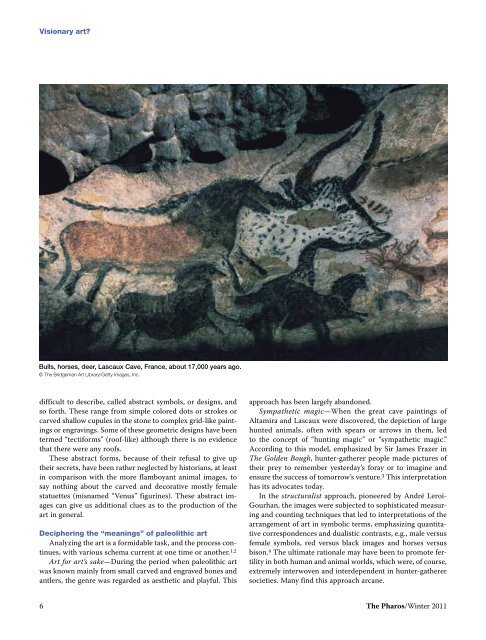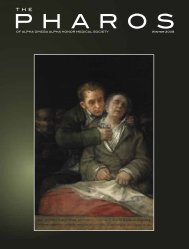Download The Pharos Winter 2011 Edition - Alpha Omega Alpha
Download The Pharos Winter 2011 Edition - Alpha Omega Alpha
Download The Pharos Winter 2011 Edition - Alpha Omega Alpha
Create successful ePaper yourself
Turn your PDF publications into a flip-book with our unique Google optimized e-Paper software.
Visionary art?<br />
Bulls, horses, deer, Lascaux Cave, France, about 17,000 years ago.<br />
© <strong>The</strong> Bridgeman Art Library/Getty Images, Inc.<br />
difficult to describe, called abstract symbols, or designs, and<br />
so forth. <strong>The</strong>se range from simple colored dots or strokes or<br />
carved shallow cupules in the stone to complex grid-like paintings<br />
or engravings. Some of these geometric designs have been<br />
termed “tectiforms” (roof-like) although there is no evidence<br />
that there were any roofs.<br />
<strong>The</strong>se abstract forms, because of their refusal to give up<br />
their secrets, have been rather neglected by historians, at least<br />
in comparison with the more flamboyant animal images, to<br />
say nothing about the carved and decorative mostly female<br />
statuettes (misnamed “Venus” figurines). <strong>The</strong>se abstract images<br />
can give us additional clues as to the production of the<br />
art in general.<br />
Deciphering the “meanings” of paleolithic art<br />
Analyzing the art is a formidable task, and the process continues,<br />
with various schema current at one time or another. 1,2<br />
Art for art’s sake—During the period when paleolithic art<br />
was known mainly from small carved and engraved bones and<br />
antlers, the genre was regarded as aesthetic and playful. This<br />
approach has been largely abandoned.<br />
Sympathetic magic—When the great cave paintings of<br />
Altamira and Lascaux were discovered, the depiction of large<br />
hunted animals, often with spears or arrows in them, led<br />
to the concept of “hunting magic” or “sympathetic magic.”<br />
According to this model, emphasized by Sir James Frazer in<br />
<strong>The</strong> Golden Bough, hunter-gatherer people made pictures of<br />
their prey to remember yesterday’s foray or to imagine and<br />
ensure the success of tomorrow’s venture. 3 This interpretation<br />
has its advocates today.<br />
In the structuralist approach, pioneered by André Leroi-<br />
Gourhan, the images were subjected to sophisticated measuring<br />
and counting techniques that led to interpretations of the<br />
arrangement of art in symbolic terms, emphasizing quantitative<br />
correspondences and dualistic contrasts, e.g., male versus<br />
female symbols, red versus black images and horses versus<br />
bison. 4 <strong>The</strong> ultimate rationale may have been to promote fertility<br />
in both human and animal worlds, which were, of course,<br />
extremely interwoven and interdependent in hunter-gatherer<br />
societies. Many find this approach arcane.<br />
6 <strong>The</strong> <strong>Pharos</strong>/<strong>Winter</strong> <strong>2011</strong>














